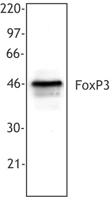-
Sign In
-

-
 Sony Biotechnology
Sony Biotechnology
-

-
 Sony Biotechnology
Sony Biotechnology
Purified anti-human FOXP3
Antibodies Single
Sony
259D
Other
Mouse IgG1, κ
Human
Full-length FOXP3 protein
2201010
$273.00
Description
FOXP3 is a 50-55 kD transcription factor, also known as Forkhead box protein P3, Scurfin, JM2, or IPEX. It is proposed to be a master regulatory gene and more specific marker of T regulatory cells than most cell surface markers (such as CD4 and CD25). Transduced expression of FOXP3 in CD4+/CD25- cells has been shown to induce GITR, CD103, and CTLA4 and impart a T regulatory cell phenotype. FOXP3 is mutated in X-linked autoimmunity-allergic dysregulation syndrome (XLAAD or IPEX) in humans and in "scurfy" mice. Overexpression of FOXP3 has been shown to lead to a hypoactive immune state suggesting that this transcriptional factor is a central regulator of T cell activity. In human, unlike in mouse, two isoforms of FOXP3 have been reported: one (FOXP3) corresponding to the canonical full-length sequence; the other (FOXP3 δ2) lacking exon 2. The 259D antibody recognizes human FOXP3 epitope in the region of amino acids 105-235.
Formulation
This antibody is provided in phosphate-buffered solution, pH 7.2, containing 0.09% sodium azide.Recommended Usage
Each lot of this antibody is quality control tested by immunofluorescent intracellular staining with flow cytometric analysis. For flow cytometric staining, the suggested use of this reagent is ≤ 0.5 microg per 106 cells in 100 microL volume. For Western blotting, the suggested working dilution(s) is ≤ 5.0 microg/ml in antibody dilution buffer. It is recommended that the reagent be titrated for optimal performance for each application.
References
1. Roncador G, et al. 2005 Eur. J. Immunol. 35:1681.
2. Yang ZZ, et al. 2006. Blood 107:3639. PubMed
3. Gavin MA, et al. 2006. P. Natl. Acad. Sci. USA 103:6659. PubMed
4. Groh V, et al. 2006. Nature Immunology 7:755. PubMed
5. Tran DQ, et al. 2007. Blood doi:10.1182/blood-2007-06-094656.PubMEd
6. Long SA, et al. 2008. J Autoimmun. 30:293. PubMed
7. Gong G, et al. 2009. Blood 113:837. PubMed
8. Long SA, et al. 2009. Eur J. Immunol. 39:612. PubMed
9. Long SA, et al. 2010. Diabetes. 59:407. PubMed
10. Ferraro A, et al. 2014. PNAS. 111:1111. PubMed
11. Vudattu NK, et al. 2014. J Immunol. 193:587. PubMed
12. Dupont G, et al. 2014. Cytokine. 69:146. PubMed


